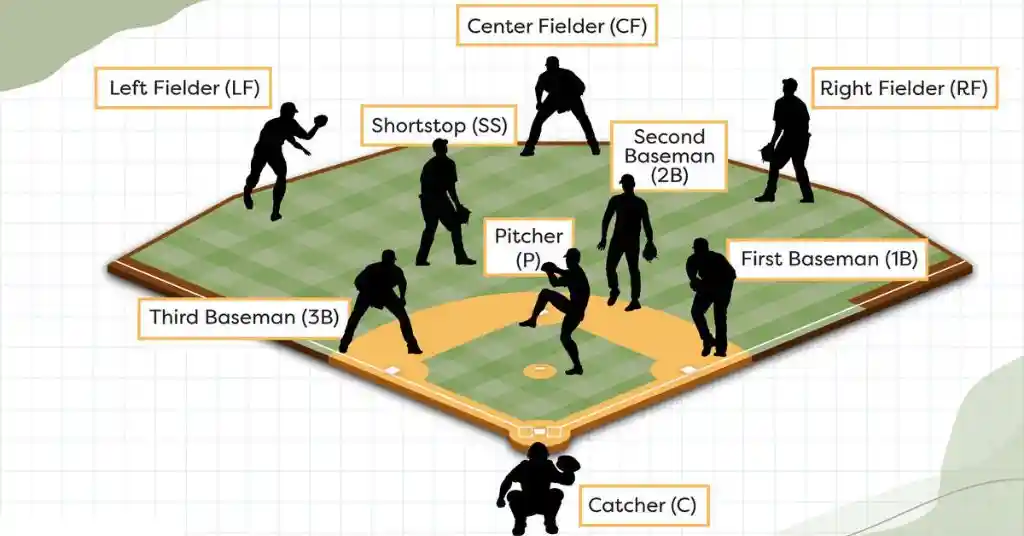
In baseball, you’ve got specialised positions on the field, but everybody has to do their part. Shortstop is one of the most crucial roles in baseball. With their lightning-quick responses and clever ability, the shortstop on the baseball diamond is an extremely important player on both sides of the ball. If you are new to the game or want to understand Baseball better, this article is for you. This article will cover the definition, duties and importance of the shortstop position in baseball.
What Is a Shortstop in Baseball?
In replying to what a shortstop does in baseball, it is worth noting that the shortstop also gets earfuls during cut-off plays. They could serve as a cutoff when the outfielders are trying to throw out a base runner. The shortstop is a key player in the infield; this player plays between second and third base and is responsible for covering the area between and near these bases. If necessary, the shortstop can enter the outfield.
Notwithstanding their defensive capabilities on the field, shortstops frequently make powerful hitters. Their job is a jack-of-all-trades; they’re expected to contribute as basemen and hitters. This combination makes the position one of the game’s most physically challenging and most strategic.Learn more about key baseball terms that help define these roles.
What Does a Shortstop Mean in Baseball?
In baseball, the shortstop’s meaning is one of those curiosities that new fans might be interested in discovering. The shortstop is essentially a player who plays between 2nd and 3rd base. The shortstop in baseball is the central figure in the infield, and they see more difficult plays than anyone else. They are generally responsible for receiving throws from the infielders, who then use the ball to complete the play with a throw to the first baseman.
Playing shortstop demands agility, a good arm, and great instincts. The shortstop is not just there to make high-percentage plays, but great plays.
Skills and Qualities Needed:
Speed and Agility:
Shortstops demand quick reactions and above-average range. They cover a lot of ground, especially on the balls hit to their left or right, and need to move quickly. Their quickness to the ball and accuracy in throwing are imperative.
Strong Arm Hard throw:
A shortstop must have a strong, accurate arm. They throw long distances into the outfield from deep in the hole at shortstop, between second and third base, to first base in a way that requires precision and arm strength. Double plays, thrown to second, also require quick, accurate arm strength.
Soft Hands:
Shortstops must handle grounders cleanly, especially on “tough hops”. Soft hands refer to a player’s ability to absorb the ball before effortlessly transitioning to a throw.
Baseball IQ:
The shortstop has to be able to read the batter’s swing, make plays, and know where the ball likely is going to be hit. Part of their job is the ability to make a quick decision and to communicate with the other infielders and the pitcher.
Communication:
Shortstops are typically the primary communicators of the infield, guiding others and yelling for the ball when it’s up for grabs. They also need to talk to the pitcher, second base and third base to ensure their fielding exposure is covered.
Offensive Role:
While shortstops are best known for their defence, they also play a significant role in the offensive aspect of the game. They are supposed to be able to hit for average and power, but historically, the position is not as home run-centric as others, the outfield and first base, for example.
Hitting:
Shortstops typically bat in the bottom half of the batting order, depending on their skills with the bat. They are going to get on base, be it through singles, walks, or average hitting.
Speed:
It is another advantageous tool for a shortstop, who can add the stolen base and get the extra base whenever possible. Some of the most successful shortstops are players with speed.

Famous Shortstops in History:
Some of the finest athletes in the annals of baseball once roamed shortstop. These include:
Ozzie Smith:
Considered by many as the greatest defensive shortstop of all time, Ozzie Smith finished his career with 13 Gold Gloves and was famous for his flashy plays and athleticism.
Derek Jeter:
One of the most storied shortstops in modern baseball. The team announced the news but did not say exactly where in Florida he was treated. Mr. Mattingly, known for his clutch hitting, leadership and durability, had played his entire career for the Yankees, winning five World Series titles.
Cal Ripken Jr.:
Once deemed the Iron Man of baseball, Ripken played 21 seasons for the Baltimore Orioles and broke Gehrig’s record for most consecutive games played. He was an excellent fielding shortstop and a potent hitting outfielder.Learn about some of the oldest MLB teams that helped shape the game and position.
What Is The Role of a Shortstop?
To understand what does a shortstop do, we need to know the responsibilities that a shortstop must perform throughout a game. The position of shortstop is typically offered ground balls hit towards the player, and they are also expected to catch line drives and high balls at shortstop. They must anticipate the ball’s path, react quickly and then throw it to the first or second baseman, depending on what is happening.
Also, in baseball, the shortstop frequently turns double plays. This is when the shortstop fields a grounder, swiftly pegs over to second base for the force-out, and then chucks the ball to first for an out (six-three, say). This crucial section halts the enemy team’s ability to advance runners and even score.
Position and Placement:

Field Position:
The shortstop plays between second base and third base on the infield. They’re generally a bit closer to second base, although they have some range based on the batter and game circumstances. Shortstops are usually right-handed, for a right-handed pull hitter will tend to hit the ball into the shortstop’s area. There are left-handed shortstops, but they are uncommon.
Duties at the Infield:
The primary responsibility of the shortstop is to cover the territory between second and third base. They have to react quickly to ground balls that are hit to the side of their body, whether routine plays or difficult, hard-hit grounders.
Key Responsibilities:
Fielding Ground Balls:
When playing defence, the shortstop is the first to field a ground ball headed towards the left side of the infield. They must be able to get low to the ground and react quickly, fielding the ball cleanly. The shortstop should also have a very good throwing arm, because many plays will end with a toss across the infield to 1st base.
Double Plays:
Double plays are another of the most important aspects of the position. That happens when the shortstop fields a grounder, throws it to second base to retire the first runner, and the second baseman (or shortstop) throws it to first base to retire the second runner. Double plays are huge and you get runners off the bases.
Coverage:
Between 2nd and 3rd This is the coverage between 3rd and 5th innings. They are responsible for making plays on any grounders or liners that get past the other members of the infield. The shortstop must also know the positions of the third baseman and second baseman in order to adapt to them.
Cutoff Plays:
When you have an outfielder who throws the ball to the infield, the shortstop is the cutoff for your outfield throws. They get the ball from an out fielder, usually the center fielder, and make a fast throw to the correct base to try to stop a runner from advancing. This is especially crucial on deeper outfield hits.
Backing Up Other Players:
The shortstop can act as a back up to other players in certain situations, thrown to first base, making sure the ball doesn’t get past the first baseman. They are also members of a highly efficient infield unit that sees plays as they develop and covers for one another.
The Value of the Shortstop in Baseball
The shortstop in baseball is more than a key figure defensively, but a captain of the infield. Sometimes, they man infield positioning during some plays and call signals to other players. Given their placement about second and third base, shortstops need a keen game sense and the ability to “hear” what the opposition is attempting to do offensively.
Moreover, the shortstop baseball meaning is more than just “the fielding” part. It also requires mental toughness, focus and and quick thinking. Reading an opponent, reading a batter’s swing and being in the right place at the right time can separate making a big play vs. giving up the bag.

Conclusion:
In short, the shortstop in baseball matters. Being an all-around type, they must have good reflexes, sharp decision-making, and fielding. Whether it is completing a double play or being in position to stop a ground ball, the shortstop is an important part of a baseball club. Comprehension of the position of the shortstop gives great insight into the strategy and importance of this key position.
FAQs:
What’s the meaning of shortstop in baseball?
The shortstop is an infielder positioned between second and third base. They field ground balls, turn double plays and assist on cut-offs. They are positioned to co-ordinate aspects of infield play.
Why is it called shortstop?
The position became known as the “shortstop” because the player played halfway between second and third bases in baseball’s early years. Their job was to short-circuit the ball that had passed the other infield posts, and the name “shortstop” was born.
What does the shortstop do in baseball?
The SS is expected to field clean ground balls and know precisely what to do: turn the double play, cut off the man, and become a leader on the field. Their release and decision-making need to be quick and accurate.
What is the role of the shortstop in baseball?
In baseball, the shortstop is the player who plays defence in the infield. They have to catch balls hit in their direction, turn double plays, and help relay throws from the outfield to ensure runners do not move up.
